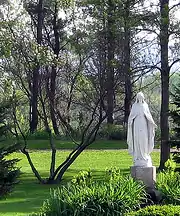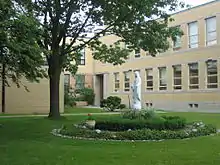Mary garden
A Mary garden is a small sacred garden enclosing a statue or shrine of the Virgin Mary, who is known to many Christians as the Blessed Virgin, Our Lady, or the Mother of God.[1] In the New Testament, Mary is the mother of Jesus of Nazareth. Mary gardens are most common to those Christian denominations which hold the Virgin Mary in special esteem, particularly Roman Catholics and Anglicans.

History
| Part of a series on the |
| Mariology of the Catholic Church |
|---|
 |
|
|
The practice originated among monasteries and convents in medieval Europe. During the Middle Ages, people saw reminders of Mary in the flowers and herbs growing around them.[2][3] The first reference to an actual garden dedicated to Mary is from the life of St. Fiacre, Irish patron saint of gardening, who planted and tended a garden around the oratory to Our Lady he built at his famous hospice for the poor and infirm in France in the 7th Century. The first record of a flower actually named for Mary is that of "seint mary gouldes" (St. Mary's Gold or Marygold) for the Pot Marigold or Calendula, in a 1373 English recipe for a potion to ward off the plague.[4]
Modern revival
The first such garden open to the public in the United States was founded in 1932 at St. Joseph's Church, Woods Hole, Cape Cod, Massachusetts.[5] This garden was founded by Frances Crane Lillie, a summer resident of Woods Hole. It was Lillie's recollection of the symbolic herbs and flowers that she had encountered in England that prompted her to conceive and donate a Mary Garden to St. Joseph's Church.[6]
Inspired by the St. Joseph's Mary Garden in Woods Hole, Edward A. G. McTague and John S. Stokes, Jr. founded "Mary's Gardens" of Philadelphia in 1951 as a project to research flowers identified with Mary, and make available seeds and plant source information for starting Mary Gardens. They also initiated a series of articles in religious publications to encourage the planting of Mary gardens.[7]
Description
A Mary garden may be a single indoor pot, a large plot outdoors, or anything in between. They can be found at parishes, schools, homes, shrines, convents and other institutions.[8]
The statue of Mary, sometimes holding the Infant Christ, is central to the garden. Select flowers, shrubs, and trees associated with the legends about Mary are planted in the garden. Such plants may include laurel trees, strawberries, ladyslippers, lilies of the valley, peonies, violets, irises and roses, all of which are identified as symbolic and significant in the story of Mary as recounted in the Bible and other Christian stories. Gardens may have benches and a facility for lighting votive candles.
It demonstrates devotional commitment through the spiritual practice of designing, building and maintaining the garden and for the attendance, contemplation, and prayers of visitors. Mary gardens are similar to the Zen meditation gardens found in the Buddhist tradition, with the exception that a Mary Garden pays homage to a person, the Virgin Mary, whereas a meditation garden in the East Asian traditions does not focus on a person.[9][2]
Flowers associated with Mary
More than 30 flowers and herbs are connected to legends about Mary’s life.[2]
- Lily: Mary was associated with this passage from the Song of Songs: "I am the Rose of Sharon, the lily of the valleys." (2:1) A legend from the second century says that when Mary's tomb was opened to show Thomas that her body had been assumed into heaven, it was filled with roses and lilies.[10]
- Columbine: also known as "Our Lady's Shoes", is said to have sprung up wherever Mary’s foot touched the ground on her way to visit her cousin Elizabeth.[2]
- Lavender: “Mary’s Drying Plant” was said to have received its scent after Mary laid Jesus’ clothes on it to dry.[11]
- Madonna Lily: The angel Gabriel is said to have been holding a lily, representing purity, when he appeared to Mary to announce she would bear a child; lilies are often included in artistic renditions of the annunciation.[8]
- The marigold was called "Mary's Gold" by early Christians who placed the flowers around statues of Mary, offering the blossoms in place of coins. A legend says that during the flight into Egypt the Holy Family was accosted by a band of thieves. They took Mary's purse and when they opened it, marigolds fell out.[10]
- The violet is associated with humility and became known as "Our Lady's Modesty". It was said to have blossomed when Mary replied to the Angel Gabriel, "I am the handmaid of the Lord."[10]
- Irises were used in Mary Gardens. The blade-shaped foliage denotes the sorrows which 'pierced her heart.'
Gallery
 Mary Garden at the Basilica of St. Lawrence in Asheville, North Carolina
Mary Garden at the Basilica of St. Lawrence in Asheville, North Carolina Mary garden at St. Michael's College School in Toronto, Ontario, Canada
Mary garden at St. Michael's College School in Toronto, Ontario, Canada
References
- Ann Ball, 2003 Encyclopedia of Catholic Devotions and Practices ISBN 0-87973-910-X page 341
- Krymow, Vincenzina and Frisk, M. Jean. "Honoring Mary in Your Garden", St. Anthony Messenger
- "Herbs and Flowers of the Virgin Mary", Marian Library, University of Dayton
- Stokes Jr., John S., "Mary Gardens Historical Perspective", 1991
- "Mary's Gardens", Marian Library, University of Dayton
- "The Herbs and Flowers of the Virgin Mary", Marian Library, University of Dayton
- Stokes Jr., John S., "Mary Gardens in Historical Perspective", 1991
- "Filby, Julie. "Mary garden: a flower-enhanced tranquil spot to reflect on the Blessed Mother", Denver Catholic Register, April 22,2009". Archived from the original on 2012-06-25. Retrieved 2013-05-02.
- "Create a Mary Garden". Archived from the original on 2012-03-08. Retrieved 2009-06-01.
- "May flowers", Marian Library, University of Dayton
- "Filby, Julie. "Mary garden: a flower-enhanced tranquil spot to reflect on the Blessed Mother", Denver Catholic Register, April 22,2009". Archived from the original on 2012-06-25. Retrieved 2016-12-05.
External links
- John Stokes and Mary's Gardens Collection, records of John Stokes' organization, Mary Gardens. University of Dayton Libraries.